The AMD Radeon R9 Nano Review: The Power of Size
by Ryan Smith on September 10, 2015 8:00 AM ESTCompute
Shifting gears, we have our look at compute performance.
Starting us off for our look at compute is LuxMark3.0, the latest version of the official benchmark of LuxRender 2.0. LuxRender’s GPU-accelerated rendering mode is an OpenCL based ray tracer that forms a part of the larger LuxRender suite. Ray tracing has become a stronghold for GPUs in recent years as ray tracing maps well to GPU pipelines, allowing artists to render scenes much more quickly than with CPUs alone.
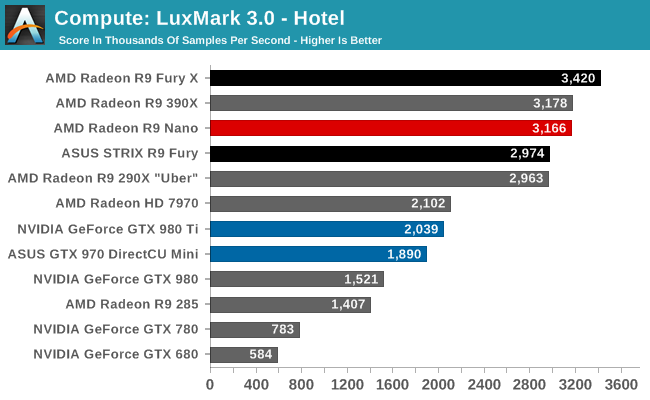
LuxMark ends up being a great corner case for where having a fully enabled Fiji GPU is more important than having the highest clockspeeds. With the R9 Nano able to flirt with its full 1000MHz clockspeed here, the card is able to pass the R9 Fury here. The only thing stopping it from taking the second-place spot is the R9 390X, as Hawaii still sees strong performance here even with fewer SPs.
For our second set of compute benchmarks we have CompuBench 1.5, the successor to CLBenchmark. CompuBench offers a wide array of different practical compute workloads, and we’ve decided to focus on face detection, optical flow modeling, and particle simulations.
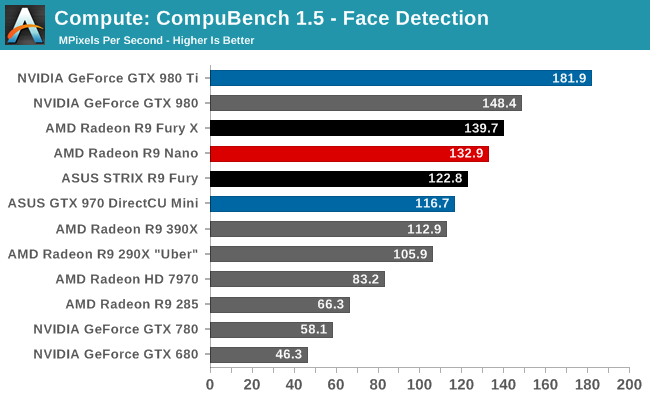
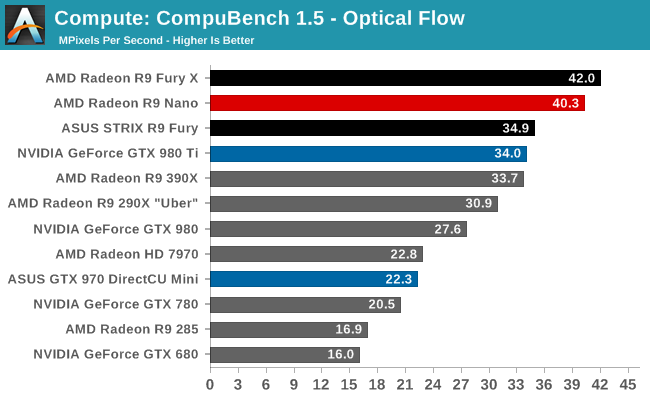
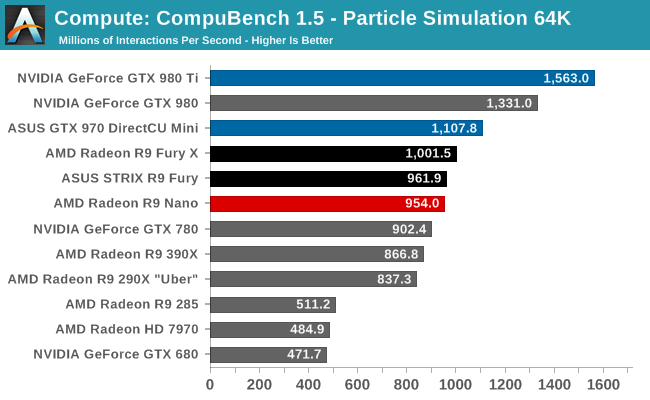
CompuBench provides us another case of where the R9 Nano ends up outpacing the R9 Fury. As a result AMD’s latest card tends to perform somewhere between an R9 Fury and R9 Fury X, with all of the strengths and weaknesses that come from that. This puts the R9 Nano in a good place for Optical Flow, while it will still trail NVIDIA”s best cards under Face Detection and the 64K particle simulation.
Meanwhile it’s interesting to note that AMD’s particle sim scores have significantly improved in the recent drivers. GCN 1.2 cards have seen 20%+ performance improvements here, which may point to some new OpenCL compiler optimizations from AMD.
Our 3rd compute benchmark is Sony Vegas Pro 13, an OpenGL and OpenCL video editing and authoring package. Vegas can use GPUs in a few different ways, the primary uses being to accelerate the video effects and compositing process itself, and in the video encoding step. With video encoding being increasingly offloaded to dedicated DSPs these days we’re focusing on the editing and compositing process, rendering to a low CPU overhead format (XDCAM EX). This specific test comes from Sony, and measures how long it takes to render a video.
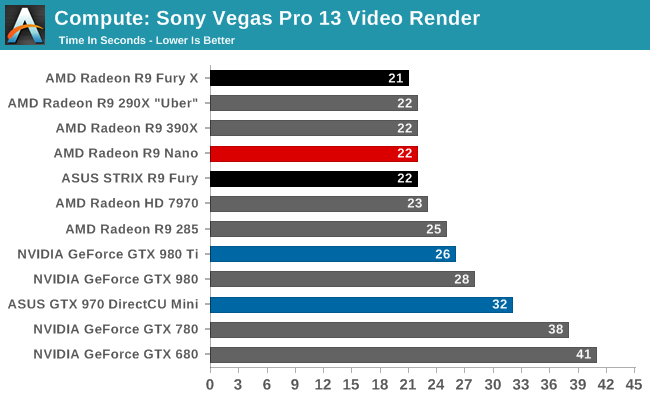
With Vegas there are no surprises; the R9 Nano ties the R9 Fury.
Moving on, our 4th compute benchmark is FAHBench, the official Folding @ Home benchmark. Folding @ Home is the popular Stanford-backed research and distributed computing initiative that has work distributed to millions of volunteer computers over the internet, each of which is responsible for a tiny slice of a protein folding simulation. FAHBench can test both single precision and double precision floating point performance, with single precision being the most useful metric for most consumer cards due to their low double precision performance. Each precision has two modes, explicit and implicit, the difference being whether water atoms are included in the simulation, which adds quite a bit of work and overhead. This is another OpenCL test, utilizing the OpenCL path for FAHCore 17.

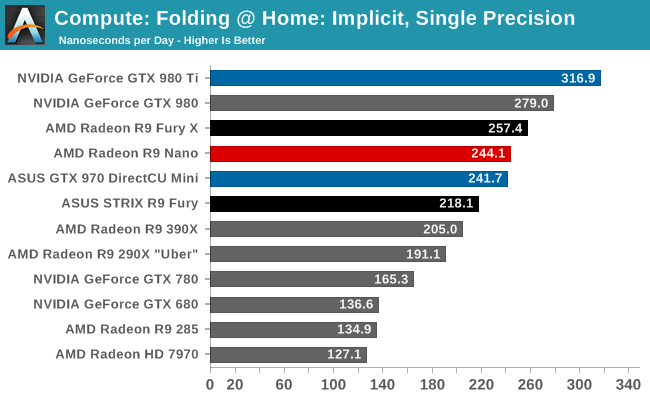
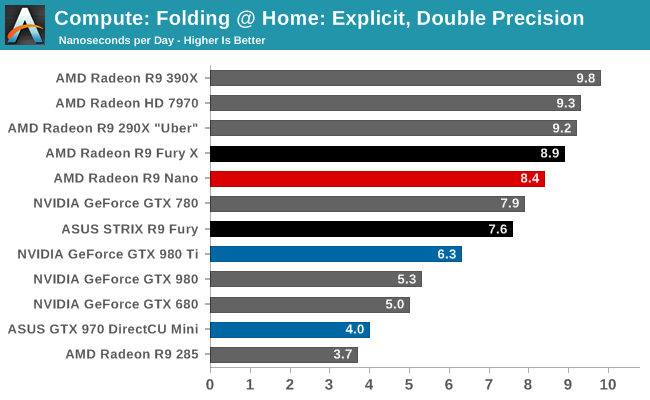
Much like CompuBench and LuxMark, the R9 Nano punches above its weight here. The lack of a graphics workload – and resulting demands on graphics hardware like the ROPs – means most of the card’s power can be allocated to the shaders, allowing higher clockspeeds. This gives the Nano a boost in this situation to bring it much closer to the Fury X, though as far as Folding goes AMD will still trail NVIDIA’s best cards.
Wrapping things up, our final compute benchmark is an in-house project developed by our very own Dr. Ian Cutress. SystemCompute is our first C++ AMP benchmark, utilizing Microsoft’s simple C++ extensions to allow the easy use of GPU computing in C++ programs. SystemCompute in turn is a collection of benchmarks for several different fundamental compute algorithms, with the final score represented in points. DirectCompute is the compute backend for C++ AMP on Windows, so this forms our other DirectCompute test.

Our final test sees the R9 Nano brought back to its place behind the R9 Fury, as the C++ AMP sub-tests are strenuous enough to cause more significant clockspeed throttling. Even behind the R9 Fury the R9 Nano does well for itself here, coming in behind the GTX 980 Ti and head of the R9 390X and GTX 980.










284 Comments
View All Comments
D. Lister - Friday, September 11, 2015 - link
It is interesting how the ratio of AMD fans on every tech website is about 50/50 with Nvidia fans, yet AMD's market share has dropped below 20%. What's up with that? Either a lot of you AMD guys aren't putting your money where your mouth is, or it's like the same 3 fanboys posting their stuff everywhere with multiple accounts. :pMathos - Friday, September 11, 2015 - link
Not really a fanboy of either side. I'm usually a fan of whatever will give me the best performance at the price point I can afford. Though currently I'm running an AMD HD7850 2GB, because thats what was best at below 200$ at the time I bought it.itproflorida - Friday, September 11, 2015 - link
coincidence I am replying to your post, but of course your not a fan but you will buy another amd card, good for you.Mathos - Friday, September 11, 2015 - link
Look I've probably been building and upgrading computer systems, longer than you've been alive there buddy, I've own more video cards than you'll probably ever know. Many of which predate both nVidia and ATI. I'm buying the R9 Fury, because at 550$, it's faster than similarly priced GTX 980's in the games that I have and play. Don't get me wrong, if I could afford more, I'd buy a 980ti. Unlike you, I apparently read bench marks and multiple reviews on such things. Plus I'm not one of these dumb people who buy x brand because they have the fastest top end card.... even though another brand has something faster at the price point I'm looking at.And speculation you say? Even though I've already been using said features with my 7850? Mostly just the frame rate limit settings to save power at the moment. Also.... have you not seen the performance difference with the DX 12vs11 benchmarks on other sites?
D. Lister - Friday, September 11, 2015 - link
@MathosI think there is a misunderstanding here - my statement was based on a general observation, not pointed at anyone in particular. You could attach a hamster wheel to your gpu slot and I wouldn't mind as long as you feed the hamster, not to mention it would work nearly just as well for Project Cars or Witcher 3 for less money. Sorry, couldn't resist. :D
Mathos - Saturday, September 12, 2015 - link
Oh no, wasn't replying to you, was responding to that Florida person on that harsh reply. As far as your's yeah I figured that. It was kind of ironic, that a fan boy came out to attack my choice on the other post though. I'll have to check out the project cars and witcher 3 bench's. Don't play many racing games, other than Grid and Dirt. I still haven't finished Witcher 1, not worried much about Witcher 3 for a while.Beany2013 - Sunday, October 4, 2015 - link
Anyone who publicly describes themselves as a 'pro', and subsequently can't even manage basic grammar and punctuation needn't be listened to. Simple as that.medi03 - Saturday, September 12, 2015 - link
That's because most of the uneducated public with little clue buys nVidia.HollyDOL - Saturday, September 12, 2015 - link
Funny enough, I started to buy nVidia after I become educated in 3D graphics. At that time ATI provided such a terrible developer experience I doubt I'd be able to forgive&forget yet in next few years.medi03 - Sunday, September 13, 2015 - link
nVidia outsold AMD even in Fermi times, with slower, more expensive, more power hungry chips.So, nope, sorry to bust your bubble.